26 November 2006
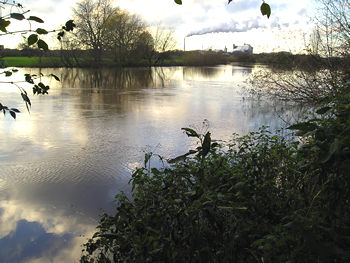
I’m trying to avoid the Christmas shoppers, so I’m going the other way. As far away as possible. I started thinking I’d have a quick late afternoon dash around the “Lammas Lands”. It turned into a surprisingly interesting riverside wander, all watery, green and blue, the light reflected from unexpected lakes.
Down here by Clifton Bridge, the river is up. Well, the whole river is up, obviously, not just this bit. It’s all bigger and wider.
I do not know much about gods; but I think that the river
Is a strong brown god – sullen, untamed and intractableT S Eliot – The Dry Salvages
(If you’re interested, its added wideness can be seen by comparing it with a photo from a few weeks ago, taken from exactly the same place – see the second photo down on Sugar beet and Lammas Lands.)
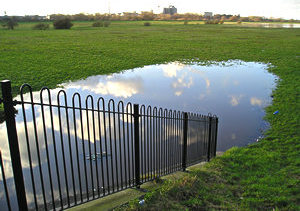
When I was here a few weeks ago the land here was dry – well, as dry as any earth is in the late autumn. But now the ings are filled with pools of water, reflecting the sky. Here just behind the flood gates, with the factory on the horizon behind. Late in the afternoon, as the light fades, it’s good to have a double helping of blue sky, above and below.
I marched along happily for some distance, intending to go through Rawcliffe Meadows, but was stopped en route abruptly by the waters, covering the path ahead. I tentatively attempted to cross, but wimped out once the water started lapping over my boots. Turning back, I met a couple walking their dog. They were properly kitted out, with large wellies on (just the couple, not the dog). They all fearlessly crossed the flooded path. I’d just got into my stride, and was looking forward to getting further away from the the confines of the city. But I didn’t fancy wading, without the appropriate footwear.
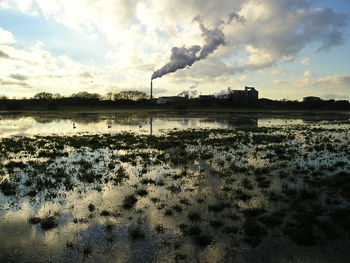
But it was worth coming down here, to see this unexpected view. All the water in unexpected places, gulls and other birds settling here, and the late afternoon sky all dramatic and moody behind the factory. And that chimney again, chugging out the steam of the last Campaign.
The floodwater here has all collected on this ings land since my last visit. The landscape has altered dramatically, within a few weeks.
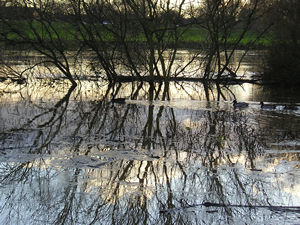
Back on the other side of the floodbank, the river’s normal edge defined by the shrubs and trees, ducks make the most of the extra water. They’re relaxing, the way they glide along, though of course under the water their little legs are going furiously.
And while I was watching them, my little brain was working – not exactly furiously – but I was thinking about how susceptible we are to these rises in the river level.
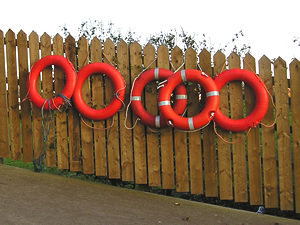
I headed back along the river path, towards the city centre. I didn’t really want to go there, but I needed some money from the cash machine. I was glad of the open space of the riverside, while psyching myself up for the approaching clamour of town. Here’s the boathouse on the river path. I think it belongs to St Peter’s School. Most things around here do. They’ve even managed to acquire a public footpath.
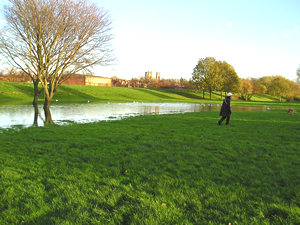
After the St Peter’s School playing fields, the riverside area opens out again to common land. This open space seems to have many different names. The Ordnance Survey map calls it Clifton Long Reach. The Environment Agency’s documentation on the York flood defences calls it Lower Bootham. My friend Vanessa has always known it as “Paddy’s Pitch”. I think I prefer that.
The Minster is visible on the horizon. When you see it across this green open land, you can imagine what it might have been like for our medieval ancestors, approaching the city on foot.
Viewing the top of the Minster over lots of green land and trees, with York quite small and defined in its boundaries, before it spread out so widely from its original centre, and got surrounded by Monks Cross, Clifton Moor, a designer outlet and a ring road.
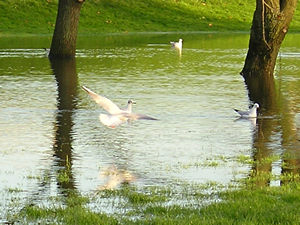
Most of us like walking by water, I guess it’s because it’s relaxing. Even more relaxing today, with all this extra water on areas that are usually grassland. Gulls are here – not our usual birds. This morning, at home, standing in the garden, I heard their strange screeching call above. We call them seagulls, but of course they’re not always hanging out by the sea. Here they’re making the most of the unexpected water on these flat riverside ings.
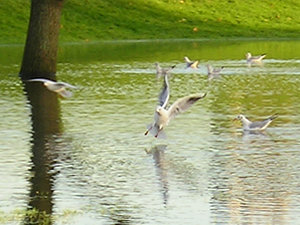
I didn’t expect to find anything interesting once I’d got diverted away from Rawcliffe Meadow and had to turn back. But the natural areas are always changing. Finding these unexpected lakes meant seeing new reflections, and new bird life. The gulls were gliding on the water, occasionally bickering, taking off and landing again. The sun had emerged from behind the moody clouds, and with no buildings to obscure it, it was strong and bright, here on the riverside.
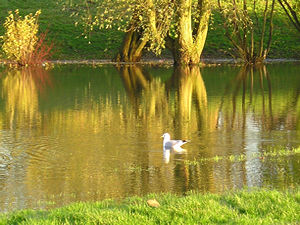
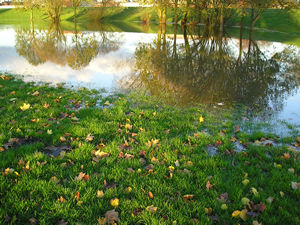
People walked by, on the riverside path. Two boys were playing football on the drier part of the grass. A dog ran into the unexpected lake, frightening the gulls, and they took off, then settled again. Trains passed on the other side of the river, crossing the points, pulling in to York station.
On the ings further up, by the factory, it had looked as if the light was fading for the day. But it reappeared from under the low clouds, strong and warm.
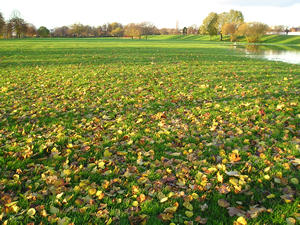
Here on this smaller ings area of Paddy’s Pitch, there’s another large earthen floodbank, curving around between the riverside area and the houses and school buildings behind. The floodbank creates a kind of bowl, which seemed to catch the sun and hold it, as it slid towards the horizon.
A woman sitting on a bench right on the riverbank seemed to have chosen her seat deliberately. The sun was right in front of her as it sank lower, and no trees on that area of the bank obscured it. This sun worship seemed appropriate, so I stood under a nearby tree, facing the same way.
Standing about in the middle of an open space for no reason can make you look a bit weird, I guess. But then I’m sure I often do. And I don’t care. I resisted hugging the tree, however.
I’d been expecting nothing from this walk, and felt like I’d ended up with everything. Proving my recent theory that the best way to cope with the shorter days at this time of the year might be to dash about a bit more, out in the open air.
Trekking stubborn through this season
Of fatigue, I shall
Patch together a contentOf sorts. Miracles occur.
If you care to call those spasmodic
Tricks of radiance
Miracles. The wait’s begun again,
The long wait for the angel,
For that rare, random descent.Sylvia Plath – Black Rook in Rainy Weather
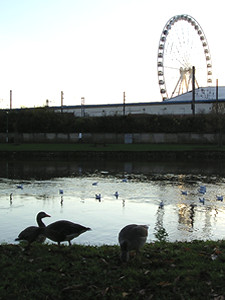
Leaving the green of Paddy’s Pitch, and continuing along the riverside path, the sun was sinking lower behind the buildings of the National Railway Museum, which we’ve been proud guardians of since the 1970s. Close by, the York Eye, a more recent addition. I’ve got no sense of pride about it, but maybe other people have. I’ve not really taken to that name The York Eye. “That big wheel thingy”, I usually call it, and everyone knows what you mean. I guess I might get around to going on it sometime. For now, here it is, silhouetted on the horizon, with some geese in the foreground. One of these was being harrassed by a dog as I passed, and put up a spirited and rather hissy defence. I like all these birds about, on and around the high river. More interesting than that wheel thing.
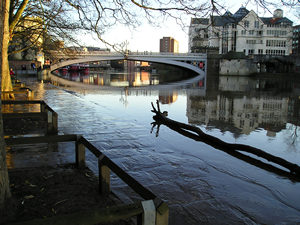
Further up, approaching the town centre, and Lendal Bridge, the paths were covered in mud, so I guess the river had been higher. It was just lapping at the edges of this raised walkway area, with the lower path that’s usually visible completely underwater. A piece of tree appeared to have been carried by the swollen river and had stuck here.
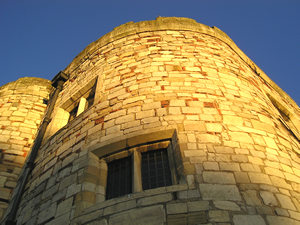
When the light sinks lower only certain buildings catch its last rays. Here is Lendal Tower, recently refurbished.
It’s an appropriate place to end this flood/water-related wander, as Lendal Tower was the building that housed York’s first waterworks, centuries ago. Originally part of the city’s fortifications, and built around 1300, it became the city’s waterworks in the 17th century, and remained as such until the waterworks moved to Acomb Landing in 1846.
English Heritage records that it is built of magnesian limestone, “much re-used and including carved fragments of canopy, finial and other mouldings from the ruins of St Mary’s Abbey.”
Historical facts aside, it looks beautiful, doesn’t it? And a good sunny image to end with, in this dark season.





Thank you for adding a comment. Please note that comments are moderated, but should appear within 24 hours.